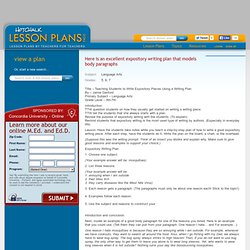

1. Object(ive) Writing: A Creative Exercise for the Composition Classroom. At the 2012 Conference on College Composition and Communication, three well-known writing scholars led a discussion on a writing exercise they'd assigned themselves.

For 30 days, each wrote for an hour about a different everyday object. After CCCC, three of us -- all friends, teachers and writers -- were energized by the idea of this activity and decided to try it out. Our Rules On each day for one month, each of us wrote for 30 minutes on one of the 30 objects we chose in advance -- each of us had selected 10. We could write about any object in any order and posted our writing on a public, communal blog. We didn't confine ourselves to any particular writing process or genre. Patrick's Ladle Laura's Retort The exercise proved to be powerful, helping us to engage one another in writing as we learned about each other, ourselves and the objects with which we interact every day.
Reflections If we believe William Carlos Willams' famous dictum, "No ideas but in things! " Expository Paragraph Is Marked by Distinctive, Teachable Pattern. Expository Writing. Expository Writing. Sociocultural theory and practices with graduate and undergraduate students.

Teaching Expository Writing Takes Longer than Losing 20 Pounds. Here is an excellent expository writing plan that models body paragraphs. Title – Teaching Students to Write Expository Pieces Using a Writing Plan By – Jamie Danford Primary Subject – Language Arts Grade Level – 5th-7th Introduction: TTW question students on how they usually get started on writing a writing piece.

TTW tell the students that she always starts with a plan. Review the purpose of expository writing with the students. (To explain) Remind students that expository writing is the most used type of writing by authors. (Especially in everyday life) Lesson: Have the students take notes while you teach a step-by-step plan of how to write a good expository writing piece. (Suppose this was the writing prompt: Think of an insect you dislike and explain why. Expository Writing Plan 1. (Your example answer will be: mosquitoes) 2.
(Your example answer will be: 1. annoying when I am outside 2. their bites itch 3. they carry diseases like the West Nile Virus) 3. Next, model an example of a good body paragraph for one of the reasons you listed. English Language Arts: Writing Prompts/Journal Topics. What is...

What is something you dislike about yourself? What is something you do well? What is your favourite room in your home and why? What is a good neighbour? What is the worst thing parents can do to their children? What if... What would happen if you could fly whenever you wanted? What do you think... What do you think of 3D movies? What...misc. What do you like most about yourself? How... How do you feel when it's your birthday? I wish... Text Structures CC Dr. Deb Wahlstrom. How to Teach Expository Text Structure to Facilitate Reading Comprehension. Click the "References" link above to hide these references. Aebersold, J.A., & Field, M.L. (1997). From reader to reading teacher: Issues and strategies for second language classrooms.
New York: Cambridge University Press. Armbruster, B.B. (2004). Considerate texts. Carrell, P.L. (1985). Dole, J.A., Duffy, G.G., Roehler, L.R., & Pearson, P.D. (1991). Fletcher, J.M. (2006). Gillet, J.W., Temple, C., & Crawford, A.N. (2004). Grabe, W. (1991). Grabe, W. (2004). Grabe, W. (2008, May, 29-31). Hall, K.M., Sabey, B.L., & McClellan, M. (2005). Horiba, Y. (2000). Kendeou, P., & van den Broek, P. (2007). Lorch, R.F., & Lorch, E.P. (1996). Meyer, J.B.F. (1985).
Meyer, J.B.F. (2003).